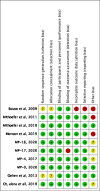The Efficacy of MDMA (3,4-Methylenedioxymethamphetamine) for Post-traumatic Stress Disorder in Humans: A Systematic Review and Meta-Analysis
- PMID: 34150406
- PMCID: PMC8207489
- DOI: 10.7759/cureus.15070
The Efficacy of MDMA (3,4-Methylenedioxymethamphetamine) for Post-traumatic Stress Disorder in Humans: A Systematic Review and Meta-Analysis
Abstract
Background: 3,4-methylenedioxymethamphetamine (MDMA), known recreationally as "Molly" or "Ecstasy", is a triple monoamine reuptake inhibitor. MDMA specifically acts as a weak 5-HT1 and 5-HT2 receptor agonist, targeting 5-HT2A, 5-HT2B, and 5-HT2C receptors. Its potential use for therapeutic purposes with these pharmacological profiles remains a controversial subject. Studies have shown the potential benefits in clinical trials for post-traumatic stress disorder (PTSD). A larger amount of data has been provided for the push in support of MDMA-assisted psychotherapy in these patients. Objective: The aim of this article is to compute a meta-analysis and conduct a systematic review of the effects of MDMA on PTSD, discussing the potential benefits and adverse events relative to dosing and stability of treatment. Methods: Articles were collected and analyzed for systematic review: 16 articles were included in the systematic review that met the criteria for the use of MDMA in the treatment of PTSD as well as assessing the safety and efficacy of the drug in human participants. Ten studies were used for the meta-analysis, with a cumulative sample size of 168 patients. The significance of the findings on dosing and efficacy of MDMA in healthy human participants was quantified based on the Clinician-Administered PTSD Scale for DSM-5 (CAPS-5) and PTSD symptom scores. Results: The disorders for which MDMA demonstrated a net positive or net negative effect on symptoms are presented separately. Adverse events in patients across all disease classes are presented. The therapeutic index for patients who demonstrated a benefit is also presented. An odds ratio for beneficial and adverse events is used to determine treatment-resistant patients who may benefit from clinical trials of MDMA. Discussion: Findings show promising evidence for the potential therapeutic use of MDMA alongside psychotherapy in the treatment of PTSD. The pharmacological profile of MDMA may provide direction for future drug developments to treat patients with treatment-resistant psychiatric disorders.
Keywords: mdma; mdma-assisted psychotherapy; posttraumatic stress; ptsd; ptsd diagnosis and treatment.
Copyright © 2021, Tedesco et al.
Conflict of interest statement
The authors have declared that no competing interests exist.
Figures














References
-
- What is MDMA? [Mar;2021 ];https://www.drugabuse.gov/publications/research-reports/mdma-ecstasy-abu... 2020
-
- Inverse: MDMA steps closer to FDA approval as a drug, but now it needs to leap. [Mar;2021 ];https://maps.org/articles/6094-inverse-mdma-steps-closer-to-fda-approval... 2021
-
- What are the effects of MDMA | National Institutes of Health. [Mar;2021 ];https://www.drugabuse.gov/publications/research-reports/mdma-ecstasy-abu... National Institutes of Health. 2020 27:2021.
-
- PTSD and DSM-5. [Mar;2021 ];https://www.ptsd.va.gov/professional/treat/essentials/dsm5_ptsd.asp 2007 5:2007.
Publication types
LinkOut - more resources
Full Text Sources
Miscellaneous
